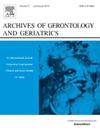Incident dementia across neighbourhood material deprivation: Implications for underdiagnosis
IF 3.8
3区 医学
Q2 GERIATRICS & GERONTOLOGY
引用次数: 0
Abstract
Background
Evidence consistently demonstrates that lower socioeconomic status (SES) confers greater dementia risk and that it is associated with poorer outcomes including reduced access to care. Furthermore, underdiagnosis is a widespread issue in dementia. However, few studies investigate whether one of the poorer outcomes associated with lower SES is a greater degree of dementia underdiagnosis.
Methods
We conducted a province-wide repeated yearly cross-sectional study (2000–17) of community-dwelling people with incident dementia in Quebec. Data were sourced from health administrative data held at the Quebec National Institute of Public Health and SES was assessed through a material deprivation index (a composite measure of the SES of census-based neighbourhoods). Given our near population-level sample, we used a descriptive approach: we described the proportion of incident dementia cases in each of 5 SES categories, from least to most material deprivation.
Results
Of the 193,834 community-dwelling people with a new diagnosis of dementia between 2000–17, around 20 % belonged to each material deprivation category on average. Incident cases in the two least deprived categories comprised 18 % each of total incident cases, and 22 % each in the two most deprived categories.
Conclusion
Despite global findings of higher dementia incidence in lower SES, we found similar incidence across levels of material deprivation. Considering that recent work indicates that lower SES in Quebec is associated with poorer health outcomes consistent with literature, our discrepant finding of comparable incidence cases in the least and most deprived neighbourhoods indicates that there is likely severe underdiagnosis of dementia in people living in more materially deprived neighbourhoods in Quebec.
社区物质剥夺的痴呆事件:对诊断不足的影响
证据一致表明,较低的社会经济地位(SES)会增加痴呆症的风险,并且与较差的结果相关,包括获得护理的机会减少。此外,在痴呆症中,诊断不足是一个普遍问题。然而,很少有研究调查与较低社会经济地位相关的较差结果之一是否为较大程度的痴呆未确诊。方法:我们对魁北克省社区居住的痴呆患者进行了一项全省范围的重复年度横断面研究(2000-17)。数据来自魁北克国家公共卫生研究所的卫生行政数据,并通过物质剥夺指数(基于人口普查的社区的社会经济状况的综合衡量标准)评估社会经济状况。考虑到我们接近人口水平的样本,我们使用了描述性方法:我们描述了5个SES类别中痴呆病例的比例,从物质剥夺最少到最多。结果在2000年至2017年间新诊断为痴呆症的193834名社区居民中,平均约有20%属于每种物质剥夺类别。两个最贫困的类别的事件案件各占总事件案件的18%,两个最贫困类别的事件案件各占22%。结论:尽管全球范围内的研究结果表明,社会经济地位越低,痴呆发病率越高,但我们发现物质剥夺水平之间的发病率相似。考虑到最近的研究表明,魁北克省较低的社会经济地位与较差的健康结果相关联,与文献一致,我们在最不贫困和最贫困社区中比较发病率的差异发现表明,生活在魁北克物质更贫困社区的人们可能存在严重的痴呆症诊断不足。
本文章由计算机程序翻译,如有差异,请以英文原文为准。
求助全文
约1分钟内获得全文
求助全文
来源期刊
CiteScore
7.30
自引率
5.00%
发文量
198
审稿时长
16 days
期刊介绍:
Archives of Gerontology and Geriatrics provides a medium for the publication of papers from the fields of experimental gerontology and clinical and social geriatrics. The principal aim of the journal is to facilitate the exchange of information between specialists in these three fields of gerontological research. Experimental papers dealing with the basic mechanisms of aging at molecular, cellular, tissue or organ levels will be published.
Clinical papers will be accepted if they provide sufficiently new information or are of fundamental importance for the knowledge of human aging. Purely descriptive clinical papers will be accepted only if the results permit further interpretation. Papers dealing with anti-aging pharmacological preparations in humans are welcome. Papers on the social aspects of geriatrics will be accepted if they are of general interest regarding the epidemiology of aging and the efficiency and working methods of the social organizations for the health care of the elderly.

 求助内容:
求助内容: 应助结果提醒方式:
应助结果提醒方式:


